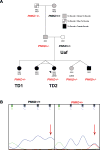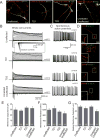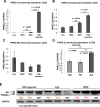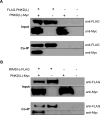The PNKD gene is associated with Tourette Disorder or Tic disorder in a multiplex family
- PMID: 28894297
- PMCID: PMC5847395
- DOI: 10.1038/mp.2017.179
The PNKD gene is associated with Tourette Disorder or Tic disorder in a multiplex family
Abstract
Tourette Disorder (TD) is a childhood-onset neuropsychiatric and neurodevelopmental disorder characterized by the presence of both motor and vocal tics. The genetic architecture of TD is believed to be complex and heterogeneous. Nevertheless, DNA sequence variants co-segregating with TD phenotypes within multiplex families have been identified. This report examines whole exomes of affected and unaffected individuals in a multiplex TD family to discover genes involved in the TD etiology. We performed whole exome sequencing on six out of nine members in a three-generation TD multiplex family. Putative deleterious sequence variants co-segregating with TD patients were identified by our in-house bioinformatics pipeline. Induced pluripotent stem cells (iPSCs) were generated from one unaffected and two TD affected individuals. Neurons were derived from the iPSCs and biochemical assays were conducted to evaluate possible molecular differences between affected and unaffected. A rare heterozygous nonsense mutation in PNKD was co-segregated with TD in this multiplex family. Transcript and protein levels of the PNKD long isoform were reduced in neurons derived from the individuals with TD due to the nonsense mutation, indicating nonsense-mediated mRNA decay. We demonstrated that the PNKD long isoform monomer oligomerizes with itself as well as interacts with the synaptic active zone protein RIMS1α. We concluded that reduced PNKD long isoform levels are detected in all affected individuals and we provide evidence for a mechanism whereby this might contribute to the TD phenotype.
Conflict of interest statement
The authors declare no conflict of interest.
Figures





Similar articles
-
Exome sequencing of a pedigree with Tourette syndrome or chronic tic disorder.Ann Neurol. 2011 May;69(5):901-4. doi: 10.1002/ana.22398. Ann Neurol. 2011. PMID: 21520241
-
Genome scan for Tourette disorder in affected-sibling-pair and multigenerational families.Am J Hum Genet. 2007 Feb;80(2):265-72. doi: 10.1086/511052. Am J Hum Genet. 2007. PMID: 17304708 Free PMC article.
-
A Whole-Exome Sequencing Study of Tourette Disorder in a Chinese Population.DNA Cell Biol. 2020 Jan;39(1):63-68. doi: 10.1089/dna.2019.4746. Epub 2019 Dec 19. DNA Cell Biol. 2020. PMID: 31855460
-
Tourette disorder and other tic disorders.Handb Clin Neurol. 2018;147:343-354. doi: 10.1016/B978-0-444-63233-3.00023-3. Handb Clin Neurol. 2018. PMID: 29325623 Review.
-
[New impulses for tic research through international collaboration].Tijdschr Psychiatr. 2015;57(12):902-6. Tijdschr Psychiatr. 2015. PMID: 26727567 Review. Dutch.
Cited by
-
Genetic Links to Episodic Movement Disorders: Current Insights.Appl Clin Genet. 2023 Mar 1;16:11-30. doi: 10.2147/TACG.S363485. eCollection 2023. Appl Clin Genet. 2023. PMID: 36883047 Free PMC article. Review.
-
Progress in Genetic Studies of Tourette's Syndrome.Brain Sci. 2017 Oct 20;7(10):134. doi: 10.3390/brainsci7100134. Brain Sci. 2017. PMID: 29053637 Free PMC article. Review.
-
Genetic architecture of Tourette syndrome: our current understanding.Psychol Med. 2021 Oct;51(13):2201-2209. doi: 10.1017/S0033291721000234. Epub 2021 Feb 22. Psychol Med. 2021. PMID: 33612126 Free PMC article. Review.
-
Tourette syndrome research highlights from 2017.F1000Res. 2018 Jul 23;7:1122. doi: 10.12688/f1000research.15558.1. eCollection 2018. F1000Res. 2018. PMID: 30210792 Free PMC article.
-
Micro-RNAs from Plasma-Derived Small Extracellular Vesicles as Potential Biomarkers for Tic Disorders Diagnosis.Brain Sci. 2022 Jun 26;12(7):829. doi: 10.3390/brainsci12070829. Brain Sci. 2022. PMID: 35884636 Free PMC article.
References
-
- Abelson JF, Kwan KY, O’Roak BJ, Baek DY, Stillman AA, Morgan TM, et al. Sequence variants in SLITRK1 are associated with Tourette’s syndrome. Science. 2005;310(5746):317–320. - PubMed
Publication types
MeSH terms
Substances
Grants and funding
LinkOut - more resources
Full Text Sources
Other Literature Sources
Medical
Molecular Biology Databases

